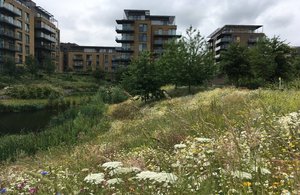Biodiversity 3.0 metric launched in new sustainable development toolkit
Natural England unveils the Biodiversity Metric 3.0 to help developments achieve biodiversity net gain and give back to nature

Today (Wednesday 7th July) Natural England (NE) launched three new tools to help developers measure biodiversity net gain and ensure new developments are “nature positive”.
Where a development has an impact on biodiversity, it will ensure that the development is delivered in a way which helps to restore any biodiversity loss and seeks to deliver thriving natural spaces for local communities.
As proposed in the Environment Bill, biodiversity net gain must be measured using a recognised biodiversity metric. The new Biodiversity Metric 3.0 will provide a way of measuring and accounting for nature losses and gains resulting from development or changes in land management.
Also announced today at an online event hosted by Natural England is the Small Sites Metric (SSM), a beta version designed to simplify the process of calculating biodiversity net gain on smaller development sites. The Environmental Benefits from Nature Tool (EBNT) was also launched to give developers a way of exploring the benefits habitats bring to people, such as improvements to water quality, flood management services and carbon storage.
Natural England chair Tony Juniper said:
Investing in Nature’s recovery is a vital national priority. These innovative new tools will help advance that ambition via the development planning process, ensuring we leave the natural environment - both terrestrial and marine - in a measurably better state than it was before.
As well as benefiting nature, biodiversity net gain can also give greater access to nature where people live and work, and can streamline the planning process by objectively and transparently quantifying any losses and gains in biodiversity.
Biodiversity Metric 3.0 will become the industry standard biodiversity metric for all on-land and intertidal development types in England, becoming a requirement for ecological consultants, developers, local planning authorities, land owners and more through the landmark Environment Bill.
Environment Minister Rebecca Pow said:
With biodiversity declining at an unprecedented rate, we must act to halt and reverse losses. We have committed to implement an approach to development that will leave the natural environment in a measurably better state than beforehand. To do this, we will be legislating for mandatory biodiversity net gain through the Environment Bill.
We are delighted to introduce the updated Biodiversity Metric 3.0, which will underpin the future requirement for mandatory biodiversity net gain and help facilitate investment in nature’s recovery through clean and green growth that brings nature to people’s doorstep.
Housing Minister Christopher Pincher MP said:
Protecting and enhancing the environment will be at the heart of our planning reforms that will deliver the new homes the country needs.
The Planning Bill will establish a clear set of rules – from where communities want homes to be built, to the high design and environmental standards that must be met – while complementing the commitments we are making in the Environment Bill.
This includes making it mandatory for the vast majority housing and developments to achieve at least a 10% net gain in value for biodiversity, ensuring new developments enhance the environment, contribute to our ecological networks and conserve our precious landscapes.
A government consultation on biodiversity net gain secondary legislation and regulations is due to launch later this year.
The new tools have received expert input from Natural England, Defra and industry to support the government’s 25 Year Environment Plan commitment to expand net gain approaches to deliver wider benefits for people and nature from development.
The government’s 25 Year Environment Plan encourages moving towards environmental net gain for all residential and infrastructure projects and makes up a key part of our landmark Environment Bill, which will ensure that the environment is at the heart of all government policy making, including meeting net-zero by 2050.
Further information:
- Biodiversity net gain does not replace existing legal or licensing habitat or species requirements and should not be applied to compensate for impacts on irreplaceable habitat features.
- Developed by the University of Oxford with expert input from across Defra family, the EBNT provides a tool to help inform decision-making and improve the design and outcomes of development, flagging relative changes in ecosystem service provision to flag areas for more detailed consideration.
- The new Biodiversity Metric 3.0 will be available on Natural England’s Access to Evidence site, as a primary forum for sharing the metric and tool and accompanying documentation. Citizenspace provides the platform for the SSM consultation document, available here.
- The EKN Network provides updates to bodies with an interest in natural capital.